 |
|
Here and There introduces art, artists, galleries, museums, and other cultural facilities around Japan that non-Japanese readers and first-time visitors may find of particular interest.
|
|
 |
|
|
 |
 |
Vertical Landscapes: Shintaro Tanaka at the Ichihara Lakeside Museum
Alan Gleason |
 |
The Landscape Veers Perpendicularly (1985), acrylic on canvas, copper. |
Shintaro Tanaka (1940-2019) burst upon Japan's art scene with a dramatic flourish at the tender age of 19. Born in Tokyo and raised in Ibaraki, a coastal prefecture to the northeast, he had just moved to the capital upon graduating from high school to pursue a career as an artist. He was still a complete unknown, without formal art training, when he won a prize at the Niki Exhibition in 1959 for an assemblage on canvas of debris that had drifted ashore in his seaside hometown of Hitachi. Critical acclaim followed, and the following year he was invited to join the Neo-Dadaism Organizers, a prominent avant-garde group founded by such luminaries as Genpei Akasegawa and Ushio Shinohara. Since then Tanaka has been a conspicuous presence, and influence, in Japan's contemporary art milieu.
|
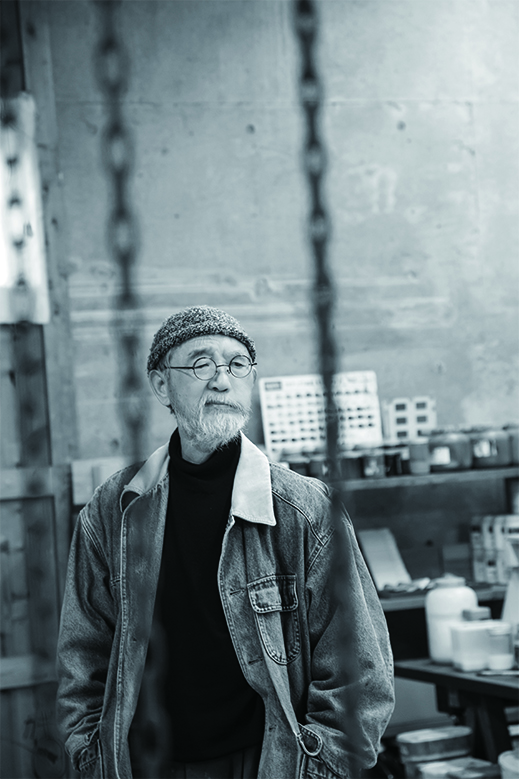 |
|
|
|
Shintaro Tanaka
|
An excellent Tanaka retrospective is now on view at the Ichihara Lakeside Museum in Chiba Prefecture, across Tokyo Bay from the capital. Named after one of the artist's most iconic series, The Landscape Veers Perpendicularly focuses mainly on his work from the mid-1980s on. Protean, prolific, and restless, Tanaka did not stick to the Dadaist style of his early mentors for very long, quickly veering into a more minimalist approach that underwent frequent permutations for the duration of his long career. Aside from a few years of serious illness in his early forties, Tanaka was active until his death last year at 79, continuing to work in his Hitachi studio. In later years he became particularly well-known for the numerous outdoor sculptures he created on commission.
|
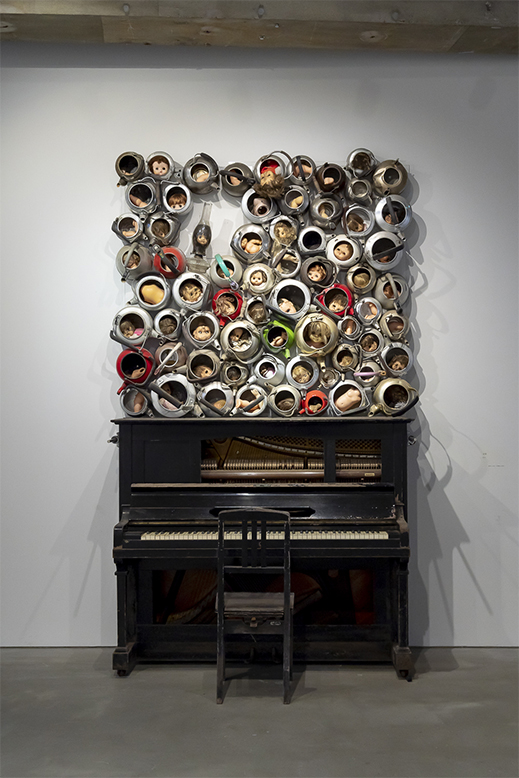 |
|
|
|
Music (1963/1996), piano, kettles, dolls, acrylic plates, chair. Photo by Yuichiro Tamura
|
The Ichihara exhibition touches very briefly on Tanaka's early Dada phase, represented here by a 1996 reconstruction of Music, a 1963 assemblage of dismembered doll heads and other appendages protruding from an array of tea kettles stacked atop an upright piano. Though perhaps derivative of other Dadaist works, it testifies to Tanaka's sharp compositional eye and his penchant for juxtapositions of unusual forms and materials.
In the late sixties and early seventies Tanaka devoted himself to more conceptual and minimalist works with an emphasis on "points, lines and planes," including submissions to the Biennales in Paris and Venice. For the latter, in 1972, he hoisted up a large square slab which accidentally crashed to the floor, landing at an oblique angle and suffering a noticeable crack. Pleased with this chance development, Tanaka displayed the piece as it was. Though no works from this period appear in the Ichihara show, there are ample photographs and videos showing these installations and how they were made.
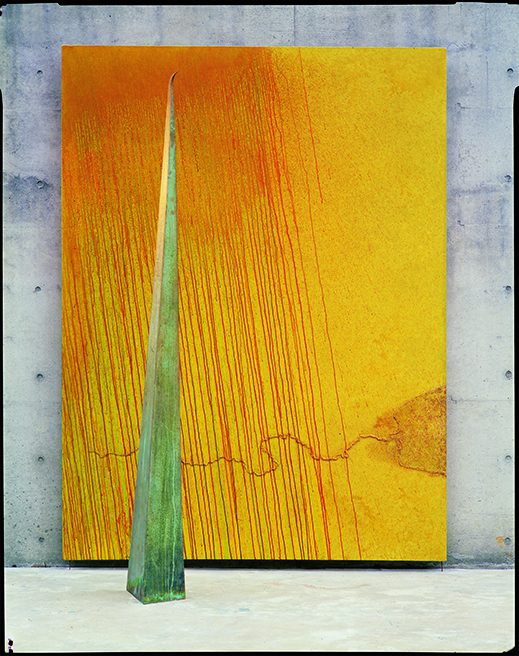 |
|
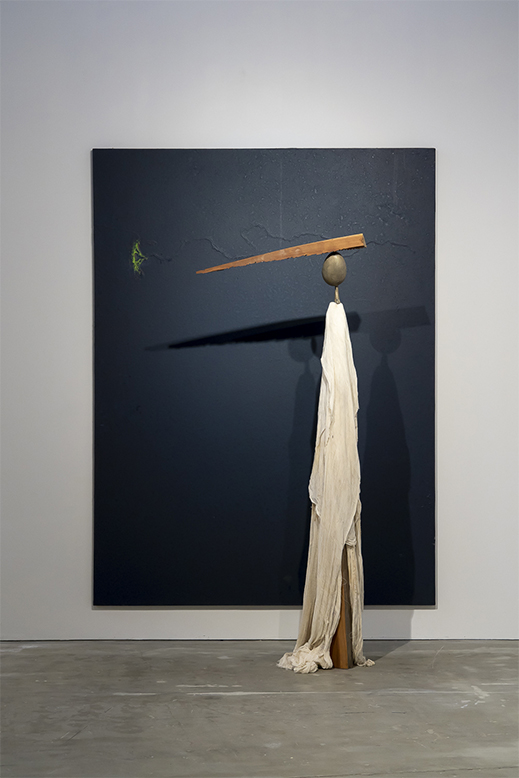 |
|
|
|
|
Why Is There No Shade in the Garden? (1986), acrylic on canvas, copper.
|
|
The Landscape Veers Perpendicularly II (1992-93), acrylic, wood, aluminum. Photo by Yuichiro Tamura |
Though incapacitated by illness for five years in the early eighties, Tanaka recovered and began a period of creativity that lasted until his death, and it is this "late period" that is the focus of the show. Soon after his recovery he embarked on a series of multimedia works that combine acrylic paintings on canvas with standalone metal sculptures, sometimes cloaked in fabric. A persistent motif in the paintings is the River Nile, whose distinctive course snakes across the canvas from source to delta, sometimes vertically, sometimes laterally. Tanaka explained that the Nile's image on a map reminded him of a streak of lightning he witnessed over the sea while he was convalescing at his Hitachi home. In that instant he realized that landscapes and other natural phenomena can be vertical -- hence the title of this series, lent also to the exhibition. The delta motif -- or perhaps it is a womb -- also appears in other works of this period, such as Heat Shimmer in Nirvana or From Beyond the Womb.
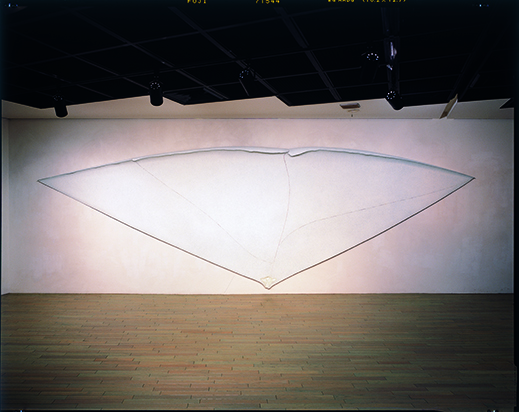 |
|
Heat Shimmer in Nirvana or From Beyond the Womb (1992-93), acrylic paint on fiber-reinforced plastic. Photo by Shigeo Anzai |
In the late 1990s and early 2000s, Tanaka resumed his exploration of "point-line-plane" minimalism in sculptural pieces like ○△□ ('Hou' 'Rin' 'Ritu') (2001), a room-sized construction of a circle, triangle, and square, each standing three meters high and anchored to a small brass object of the same form in three dimensions. He also created light installations of fluorescent tubing like Room of Maria (2014), as well as numerous egg-shaped sculptures, such as the shiny black monolith Birth (2001). In fact, the centerpiece of the Ichihara show is a gallery in which these three works are arranged for maximum visual interaction. Greeting the eye as one gazes the length of the three geometric forms is the ceiling-high fluorescent cross, which is also reflected on the surface of the big black egg standing to the side.
Exhibition view with ○△□ ('Hou' 'Rin' 'Ritu') (2001), Room of Maria (2014), and Birth (2001). Photo by Yuichiro Tamura |
Later in life Tanaka enjoyed increasing public visibility with a series of outdoor installations, many of them puckish and quite accessible. His Red Dragonfly sculptures feature a bug-eyed, downright cute insect atop various poles of whimsical design. One, which originally stood outside his Hitachi atelier, now greets visitors to the Ichihara Lakeside Museum, while a 16-meter-high variant soars over the site of the Echigo-Tsumari Art Triennale in Niigata.
The ○△□ Tower and the Red Dragonfly (2000), iron, stainless steel, urethane coating; located in Matsudai, Niigata. © Echigo Tsumari Executive Committee |
The museum's layout is eminently suited to this mix of two- and three-dimensional art. The entire building is designed as a series of curved spaces extending from a cylindrical core, and the two floors of galleries are connected by an atrium-like cut through the center. The exposed ceilings and raw concrete walls and flooring might feel a little too industrial, but this impression is softened by the curving surfaces that predominate throughout.
Credit for this design goes to Kawaguchi Tei Architects, who were commissioned to renovate the building in 2013. The original cylindrical core was part of an outdoor sculpture park built in 1995 by the city of Ichihara next to Lake Takataki, which had been created by damming the Yoro River. Naoko Kawaguchi and Jinyu Tei stripped the paint from the concrete walls, opened up the interior, and enlarged the gallery spaces, allowing the newly christened Ichihara Lakeside Museum to hold major exhibitions like this one.
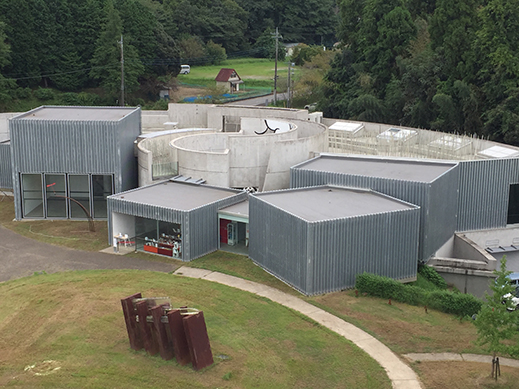 |
|
Aerial view of the Ichihara Lakeside Museum, with sculptures visible on the roof and lawn. Photo by Alan Gleason |
There is also an attractive permanent collection on show of prints by the copperplate artist Yukio Fukazawa, but above all, the museum and its surroundings are a showcase for contemporary sculpture. Several large works occupy the greensward leading down to the lake. One of the most interesting, Katsuyuki Shinohara's Just Landed (1999), invites visitors to stroll through its labyrinth-like interior. The museum roof, accessible by stairs, is covered with a forest of 700 transparent vertical tubes that make up the Acconci Studio installation Museum-Stairs / Roof of Needles & Pins (2013).
Curiously, though, the structure that dominates the entire setting is not a sculpture at all, but a 28-meter-high observation tower that looms over the lake. This is actually a demonstration model of a pumping station built to carry water from the lake to the surrounding farmland; with its two gargantuan water wheels, it's an impressive piece of work in its own right. A hike up the stairs to the top offers a fine view not just of the lake, but also of the museum's intriguing layout. Located smack in the center of the bucolic Boso Peninsula, this is an ideal destination for a day trip from Tokyo to enjoy some fresh air and thought-provoking art. The pizzeria next to the museum, with its tasty lunch menu and lovely lakeside view, is an added perk.
Though the museum is owned and operated by the city of Ichihara, its special exhibitions are managed by Tokyo's Art Front Gallery, which also runs the Echigo-Tsumari Triennale. In tandem with the Ichihara show, the gallery is currently displaying a smaller but complementary and equally fascinating selection of Tanaka's work, centered around his 1990 Han series of large abstract acrylic drip paintings.
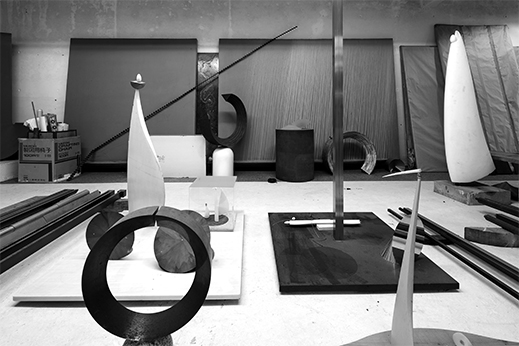 |
|
A gallery at the Ichihara Lakeside Museum reconstructs Tanaka's atelier in Hitachi, full of mockups of his public sculptures. |
All works shown are by Shintaro Tanaka; all photos are courtesy of the Ichihara Lakeside Museum unless otherwise specified. |
 |
| Shintaro Tanaka: The Landscape Veers Perpendicularly |
| 8 August - 18 October 2020 |
| Ichihara Lakeside Museum |
75-1 Funyu, Ichihara, Chiba
Phone: 0436-98-1525
Hours: 10 a.m. to 5 p.m. Tuesday - Friday; 9:30 a.m. to 7 p.m. Saturday and days before holidays; 9:30 a.m. to 6 p.m. Sunday and holidays; closed Mondays and year-end holidays. (When Monday is a national holiday the museum is closed on the following day instead.)
Access: By train, 20 minutes' walk or 5 minutes by taxi from Takataki Station, which is 40 minutes on the Kominato Railway from Goi Station on the JR Uchibo Line, accessible from Tokyo Station via the JR Keiyo Line (total travel time from downtown Tokyo is about 2 hours). By bus, 5 minutes by taxi from Ichihara Tsurumai Bus Terminus, about an hour by expressway bus from Tokyo Station.
|
| Shintaro Tanaka's Exhibition |
| 11 September - 11 October 2020 |
| Art Front Gallery |
Hillside Terrace A, 29-18 Sarugaku-cho, Shibuya-ku, Tokyo
Phone: 03-3476-4869
Hours: 12 noon to 7 p.m. Wednesday - Friday; 11 a.m. to 5 p.m. Saturday and Sunday; closed Monday and Tuesday
Access: 5 minutes' walk from Daikanyama Station on the Tokyu Toyoko Line |
|
|
|
| |
 |
Alan Gleason
Alan Gleason is a translator, editor and writer based in Tokyo, where he has lived for over 30 years. Since 2006 he has edited artscape Japan and written the Here and There column, as well as translating the Picks reviews. He also edits and translates works on Japanese architecture, music, and theater. |
|
|
|
|
|
|
|
|
|
 |
|